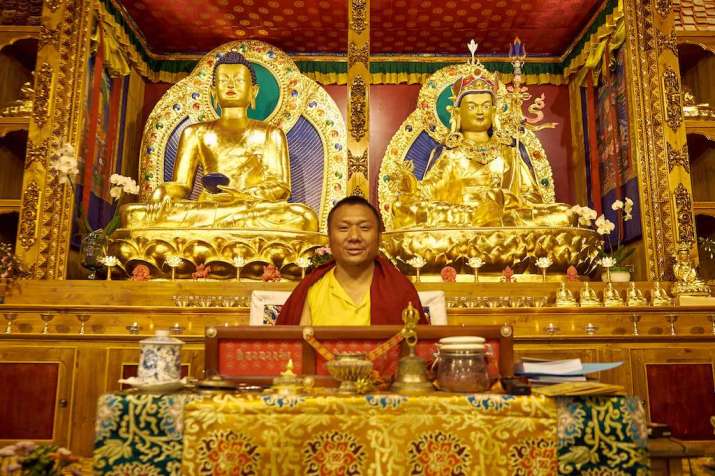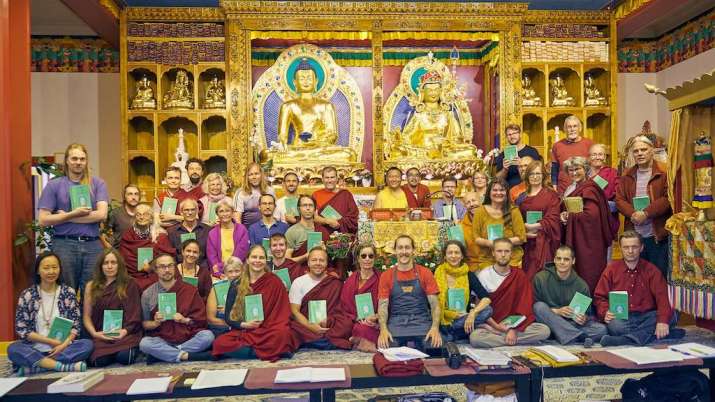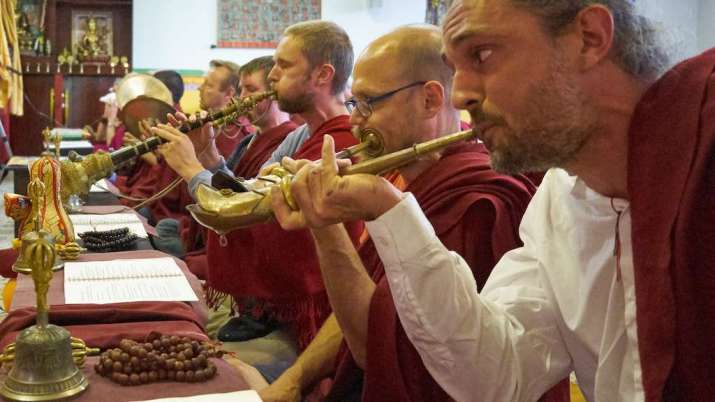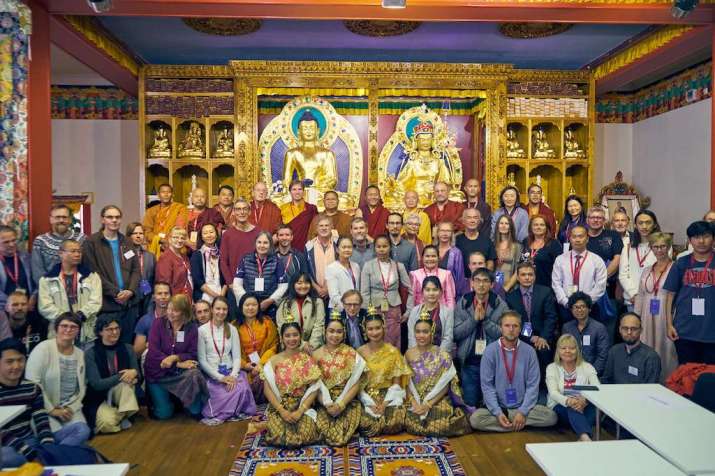FEATURES|THEMES|People and Personalities
A Diamond in Snow: Tulku Dakpa Rinpoche’s Buddhist Community in Finland
 Image courtesy of Tulku Dakpa Rinpoche
Image courtesy of Tulku Dakpa RinpocheIn 1999, a Tibetan-born lama found himself on European soil for the first time after taking a break from his arduous studies at Ngagyur Nyingma College in India. Although he first began teaching in Belgium, Tulku Dakpa Rinpoche soon began giving weekend teachings in Finland, encountering growing numbers of Finns—who hail from a largely secular, liberal, freethinking culture—who wanted to know more about Buddhism. “Many Finns were interested in the Dharma,” Rinpoche recalled. “And they requested that I stay longer and teach continuously. It seemed to me that I could make a difference here as there were no permanently residing Buddhist teachers in the country at the time, so I continued returning, met more and more people, and my activities grew.”
Tulku Dakpa Rinpoche was born in 1975 to a pious mother and father, and recognized by His Holiness Mindrolling Trichen Rinpoche (1930–2008) as the third incarnation of Gegong Rogza Sonam Palge Rinpoche, a mystical and revered emanation of Vajrapani. He began visiting Finland regularly in 2005 after his nine-year monastic studies concluded, staying for six months each year and splitting his time between Scandinavia and India. In the same year, Rinpoche established the Danakosha Dharma Center, yet it was only in 2016 that he and his supporters purchased a country property to serve as a community center. To date, this is the only traditional Tibetan Buddhist center in Finland.
 Image courtesy of Tulku Dakpa Rinpoche
Image courtesy of Tulku Dakpa RinpocheWhile Finland’s religious culture is very different from that in Rinpoche’s Tibetan homeland and the Tibetan community-in-exile in Dharamsala, where he has spent much of his life, Rinpoche has encountered few problems communicating the Buddhist teachings. After all, the Buddha’s word is theoretically the same everywhere. “I am emphasizing spreading the Buddha’s word. No matter the cultural background, we should not change the Buddha’s word or Dharma,” said Rinpoche. “I have met different Buddhist traditions—Chinese, Vietnamese, Thai, Burmese, Zen. When talking about the Buddha’s words, we have the same understanding. Even other religions share a similar understanding. All religions aim to seek compassion, loving-kindness, and the only differences lie in the methods and how they express themselves.
Nevertheless, the differences between Tibetan and Finnish students of the Dharma are an important consideration. “In Tibet, from childhood onward, one participates in all kinds of Buddhist events and activities. Even without knowing high philosophy, there is a strong belief in the Buddha, the Dharma, and the Sangha,” Rinpoche explained. “Westerners study Buddhist philosophy and read many books, acquiring a lot of knowledge, yet their belief and devotion to the three jewels is not strong. Some Tibetans, even though they claim to not be Buddhists, hold inside them strong hope and faith in the Buddhadharma. In the West, even people who claim to be Buddhists find it difficult to produce the confidence in the Buddhadharma that empowers them to take seriously ideas such as the accumulation of merit or the path of enlightenment. That is a general comparison. Both roads to Buddhism possess good and not-so-good aspects.”
 Practitioners at Danakosha Dharma Center. Image courtesy of Tulku Dakpa Rinpoche
Practitioners at Danakosha Dharma Center. Image courtesy of Tulku Dakpa RinpochePerhaps it is from his desire to nurture both “wings” of learning styles—Tibetan and Finnish—that in addition to the Danakosha Dharma Center in Findland, Rinpoche also established the Danakosha Trust in 2008 for his root Gegong Monastery’s area of Dzachuka in eastern Tibet. “When I visited my previous incarnation’s monastery, more than 100 representatives of the monastery and local nomads signed a petition asking me to build some kind of education center there. Because of that I had to establish the Danakosha Trust in Finland, through which we built classrooms for 80 students. The project was mostly aimed at the monks. The place is at a very high altitude and far from big cities, making everything very expensive, so we could not build as much as we originally wished.”
Finally, Danakosha Ling—a separate project in Dege, in the traditional region of Kham—consists of a Buddhist temple and a dormitory for 32 people. “We are raising funds to pay modest salaries for teachers. Our main aim is to make it a place for the study of Buddhist philosophy and meditation. Aside from that, we hope to improve social and ethical dialogue through organizing events such as international seminars on secular ethics involving scientists.”
While it may be too early to judge the advancement of the Buddhist diffusion in Finland, the signs over the past 30 years, in Rinpoche’s assessment, have been encouraging. “These days, with all the modern technology available to us, the mind is distracted and very busy. Because of that, people are stressed and often depressed. In general, they are looking for a calm and clear mind, so for those reasons they are approaching the Buddhist teachings,” said Rinpoche. “Because of the busy-ness of their lives and their lack of diligence when practicing the Dharma, it is difficult to judge their progress within 15 years. However, most of the people I’ve met continue their practice, which makes me happy.”
 Image courtesy of Tulku Dakpa Rinpoche
Image courtesy of Tulku Dakpa RinpocheIn particular, Rinpoche singles out Buddhist education and practice as good examples of progress. “However, there are always challenges. I identify these as people’s own minds and the dominance of materialism and attachment to outer things.”
Rinpoche is concerned that these biases toward outer forms of happiness, from things to people, distorts priorities. He offered these concluding thoughts on the role of the teacher in shifting this materialistic culture back toward one of inner spiritual vocation: “As I mentioned before, it is very hard to find time to study and practice. I think one of the most important things is for Buddhist teachers to teach as much as possible and to act in accordance with the teachings. The education of Buddhists is the key for future development. The way to do that is, as the Buddha said, hearing, reflecting, and meditating on his teachings. These three are the real nectar of the antidote for removing negative emotions and transforming society.”
See more
Biography (Tulku Dakpa Rinpoche)
Related features from Buddhistdoor Global
Khenmo Konchog Nyima Drolma: Serving the Dharma and Sowing the Seeds of Monasticism in the West
Meritorious Gifts at Tibetan Buddhist Centers in France: Some Paradoxes
The Siikainen Stupa: The Northernmost Stupa in the World














